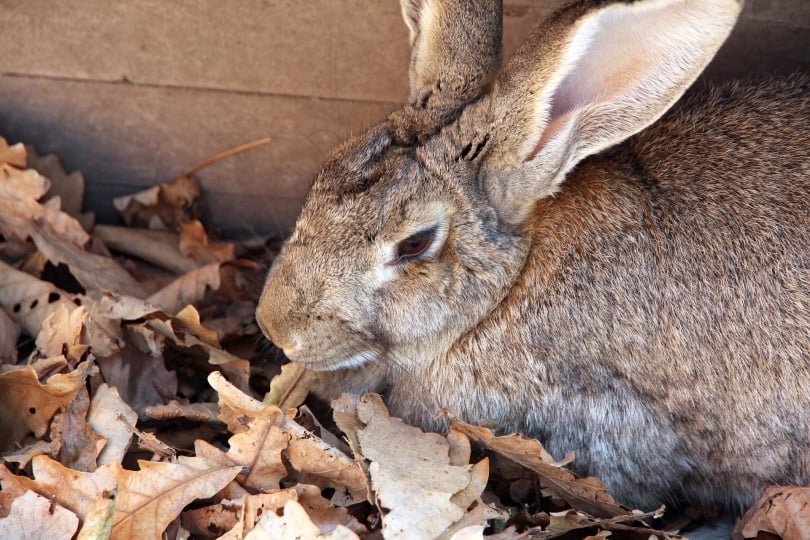While many people know a lot about domestic rabbits, few know much about wild rabbits. You know your pet rabbit is safe, warm, and happy during the harsh winter, but have you ever wondered what wild rabbits do during the winter? Since they don’t have an owner to care for them, what do they do?
How do they survive? What do they eat? In the article below, we’ll explain everything you need to know about what wild rabbits do in the winter, so join us.

Where Do Rabbits Go in the Winter?
Despite what you might assume, rabbits don’t hibernate during the winter. They spend most of their time held up in their boroughs during the winter, but they don’t hibernate. They have a crepuscular sleep cycle, meaning they come out at dusk and dawn. This sleep cycle makes it easiest to avoid predators while they search for food. The trips they make out of their borough during dusk and dawn are as short as possible in order to conserve energy to stay warm during the long winter.
But if rabbits come out to forage for food during the winter, what are they eating? Rabbits consume vegetation, most of which dies during the winter, so what are they foraging for?
 What Do Wild Rabbits Eat During the Winter?
What Do Wild Rabbits Eat During the Winter?
During warmer months, rabbits eat a diet of mostly grass with some wildflowers, clovers, and any other leafy plants they can find. This isn’t a problem in warmer areas like the American South, where the grass will still be there at the very least, but in places where winters are harsher and snow coats the ground, most of the rabbit’s food source is removed during winter.
Rabbits in these colder areas have to be less picky with their diet.

Wood-Based Diet
To survive the harsh winter, rabbits switch to a more wood-focused diet. Twigs, tree bark, conifer needles, and other edible wood are added to the menu. But rabbits don’t just go wild eating whatever they can find in a desperate attempt to beat the cold; they’re also strategic with what they choose to eat. The lack of vegetation makes it easier for predators to spot rabbits, so the rabbits typically eat in large bushes, under evergreens, or anywhere that provides food, making them harder to see.
Backyard Food Sources
This includes your backyard. Rabbits in any season, but slightly more often in the winter, will make themselves at home in fenced-in backyards. The vegetation or trees in the yard provide a food source, and a fenced-in yard provides protection from predators. However, it’s not just tree bark, pine needles, and the flowers you’ve painstakingly kept alive in your backyard that rabbits turn to during winter; many will become omnivores for survival. During the winter, many rabbits will drop their herbivore lifestyle and begin hunting insects like moths, caterpillars, ants, crickets, and even creatures as big as snails.
However, rabbits will also consume their own feces in some cases, which serves them quite well and has a few distinct advantages. The rabbits get two meals—meaning double the energy—from one foraging trip, and rabbit feces is an excellent source of vitamin B.
 How Do Wild Rabbits Stay Warm?
How Do Wild Rabbits Stay Warm?
Wild rabbits have evolved a variety of skills that they use to survive colder weather. Although some rabbits are killed by frigid temperatures, most can stay safe in warm in the winter.
Shelter
Step one for most rabbits is to find a warm shelter; this can be a deep hole they’ve dug into the ground, a hollow pile of rocks, or a hollow tree stump that may be used. Anywhere that blocks the cold air and a predator’s vision makes a good home for the rabbit. Once a rabbit has chosen its home for the winter, it begins filling it with straw and grass to use as an insulator to keep warm. Rabbits then only come out to forage at dusk and dawn, when the temperature Is milder, and the rest of the time, they remain as still as possible to conserve body heat.

Evolutionary Advantages
Physically, the rabbit also has many features to protect it from the cold, including its thick coat, which changes to a gray color in the winter to act as camouflage, and their layers of fat. Rabbits have layers of fat in their brown adipose tissue; these fat layers are burned during winter in order to maintain their standard body temperature. Combine these traits with the fact that the blood vessels in a rabbit’s ears can contract and expand to regulate body temperature, and the rabbit should have no trouble beating the cold.
The rabbit’s natural body temperature is around 102 degrees Fahrenheit, which you’d assume a rabbit in the wild would struggle to maintain in the cold, but they manage. Rabbits are actually very well prepared for the cold. As long as a wild rabbit can avoid getting wet, which could lead to hypothermia, they can survive temperatures as low as 32 degrees Fahrenheit.

Final Thoughts
As you can see, wild rabbits manage to stay warm and forage for food during winter. They have a body temperature of 102 degrees Fahrenheit, and although that seems high to us, they also have thick coats and extra fat to keep them warm.
That doesn’t mean you can’t provide food and shelter for wild rabbits in your yard but don’t expect them to come closer so you can pet them. They are much the same as domestic rabbits, but they’re afraid of people and could bite or scratch you if approached.
Related Reads:
- How to Tell the Age of a Wild Rabbit (With Pictures)
- Marsh Rabbit Breed Info: Pictures, Traits, & Facts
Featured Image Credit: swampcat1943, Pixabay
